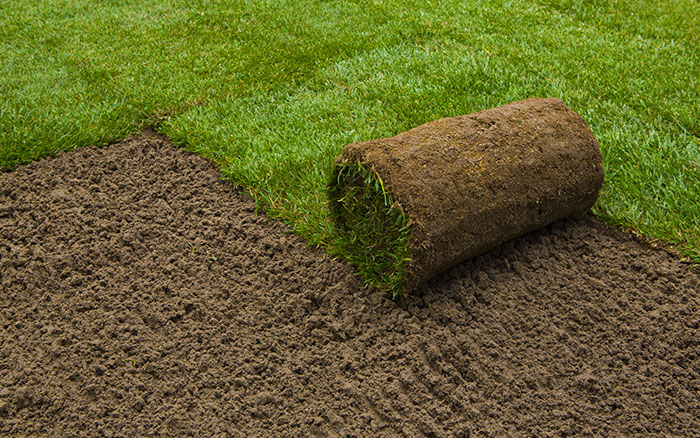March and April are months when a lot of us start to use our gardens more. If you’ve decided to replace your lawn by laying turf, this is a great time of the year to do so, as long as the soil isn’t waterlogged or frozen. Spring is just round the corner and the soil is generally fairly moist.
It’s quite a straightforward process, but there are a few golden rules to follow. With these, you should end up with a very beautiful looking, healthy lawn.
What you’ll need:
- Wheelbarrow
- Sharp spade
- Garden fork
- Garden sieve
- Organic matter such as well rotted garden compost/manure
- Rake
- Canes and string
- 10cm wide clean, straight edged length of wood
- Board wide enough to stand on (scaffold planks are ideal)
- Sharp knife
- Hose with sprinkler attached

The turf
Buy 10% more than the amount needed to give greater choice to use the best sections of turf and in case any rolls tear or are not good quality.
Try to buy and use the best quality fresh turf.
Turf deteriorates if deprived of light and moisture for too long. So, always try and lay it immediately.
However, if that’s not possible, unroll and keep it moist until you’re ready to lay it, remembering to roll it up again when you’re ready to lay as sections of the roll are likely to tear away if you try to move it unrolled.

Prepare the ground
The first and most important rule is to make sure the ground where the turf is being laid is properly prepared. Failure to do so often results in a lumpy unloved lawn with sections of it not growing well.
If you’re replacing an existing bad lawn, then remove it by slicing thinly underneath the existing turf trying to remove as little soil as possible as this is topsoil with lots of nutrients in it. The removed turf can be stored, grass side upside down, with a cover placed on it to rot down and give you loam soil to use elsewhere in the garden.
Then…
Use the garden fork to thoroughly dig over the area. This does three things; breaks up compacted soil, reveals large stones or other debris to be removed, and allows air into the soil. This is an essential process to help grass roots grow well and deep into the soil to help lessen the amount of watering needed to keep the lawn looking good and healthy.
- Dig down to the depth of your fork breaking the soil up as you dig with the side of the fork.
- Sieve out medium size stones and debris.
- Add and dig in a layer of organic matter; well-rotted garden compost or manure are both good options.
- Rake over the soil lightly, moving the rake in both directions, removing smaller stones as you go.
- Mark out the area you’re turfing using canes and string.
This next step may seem counter intuitive but it’s not…
Compress the soil lightly with your feet, doing what’s called ‘the gardener’s shuffle’, going up and down and across the freshly dug over marked out area. This ensures that the soil is both firm and level enabling roots of the turf to make contact with the soil and ‘grow away’ well. Remember you’re lightly compressing rather than heavily compacting the soil.
Next use the straight edged narrow piece of wood to literally push and pull over and along the lightly compressed area. It’s a final check that the soil is completely level, and you’ll need to squat down to do this.

Laying the turf
- Lightly firm down the turf as you finish laying each row, using the back of the rake. This is to ensure there’s good contact between the underside of the turf and the soil.
- Trim ends of the rows with the bread knife or hand saw or when needing to shape around flower beds or curving paths.
- Try to avoid using lots of small turf off cuts as they don’t root as easily and tend to dry out quickly.
- If any of the outer edges of the turf are exposed when you’ve finished, cover them with a light soil to help stop them drying out.
- Water well with the sprinkler, stand back and admire your handiwork.
- Use the wider board to stand on as you lay the turf.
- Lay the first line of turf, butting the joins closely together by pushing the turf into the joint. Never pull, as this stretches the turf and could either end up tearing the turf or creating gaps that weed seeds can lodge into and grow away.
- Move the board back and lay the second roll row tight against the first row, staggering the joints in brickwork fashion.

Remember…
Newly laid turf should never be walked on directly. Although, if you do need to then put a board down to stand on.
Continue to water the newly laid lawn regularly until you can see new shoots growing; this is particularly important in hot weather.


Leave A Comment